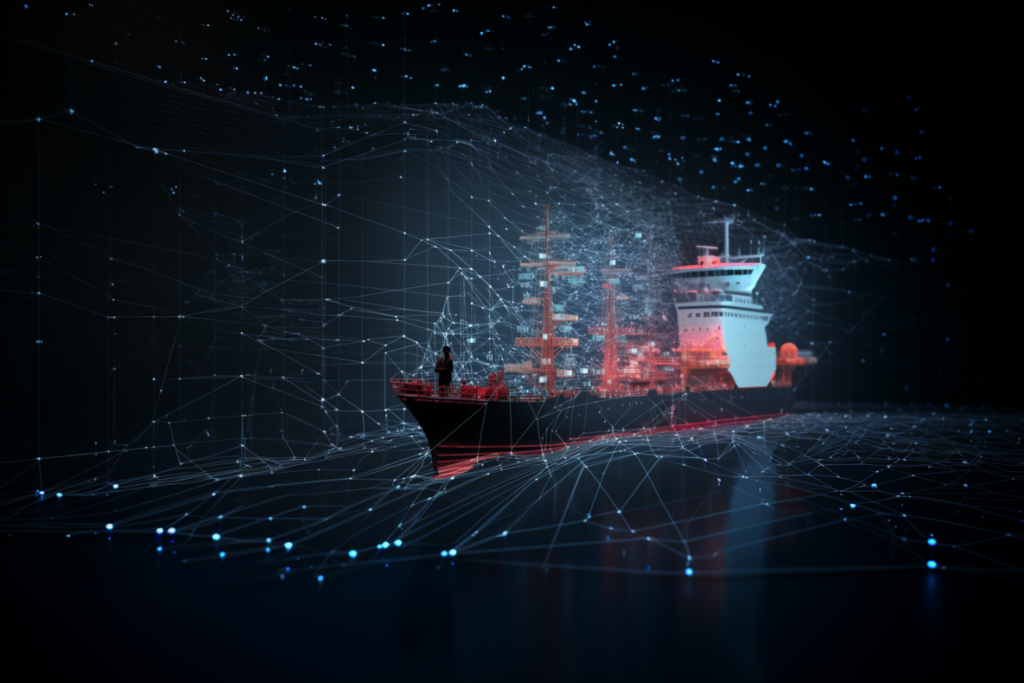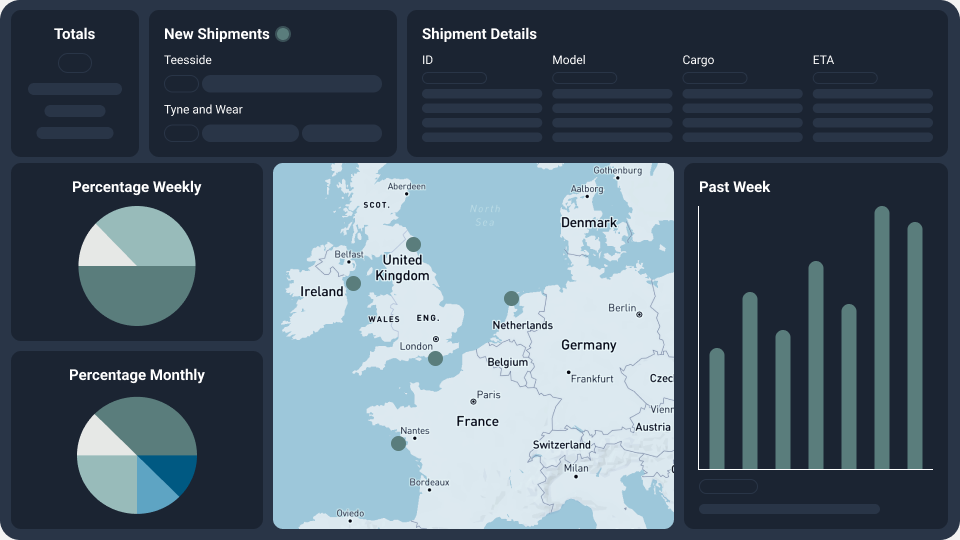Join our Mailing List to hear more!
Join the mailing list to hear updates about the world or data science and exciting projects we are working on in machine learning, net zero and beyond.

In an era where data is often referred to as the ‘new oil’, industries worldwide are leveraging its power to drive innovation, enhance efficiency, and transform traditional processes. The maritime sector, with its vast and diverse data sources, is no exception. From navigational data and weather information to ship maintenance logs and communication records, the ocean of data generated in maritime operations is as vast and deep as the seas themselves.
However, harnessing this data isn’t always smooth sailing. The sheer volume and complexity of the information can pose significant challenges, making it difficult for traditional data processing methods to extract meaningful insights. This is where the capabilities of advanced Artificial Intelligence (AI) come into play. More specifically, large language models like GPT-4 are making waves in the industry, demonstrating an exceptional ability to navigate the seas of data.
In this blog post, we will explore how large language models are revolutionizing data interpretation in the maritime sector. We will delve into the specifics of these AI models, their practical applications in a maritime context, and the implications for the industry at large. Welcome aboard as we set sail on this journey of discovery, where we uncover how AI is enabling safer, more efficient, and more sustainable maritime operations.

The Role of Data in the Maritime Industry
The maritime industry is a complex system that involves multiple moving parts – vessels, ports, cargo, crew, and routes, each generating significant amounts of data every day. The sheer volume and diversity of this data have the potential to paint an intricate picture of maritime operations, but only if we can interpret it effectively.
Data in the maritime sector can be broadly categorized into navigation data, maintenance records, weather data, and communication logs, among others.
Navigation Data: This includes information about the ship’s route, speed, and location. It is typically collected through tools like AIS, GPS and onboard sensors. Analyzing this data can help in improving voyage planning, enhancing fuel efficiency, and ensuring the safety of the crew and cargo.
Maintenance Records: These are logs of the routine checks, repairs, and replacements carried out on various parts of the ship. Analyzing maintenance records can help in predicting future maintenance needs and preventing potential equipment failures that can lead to expensive downtime or even accidents.
Weather Data: Ships continually receive updates about weather conditions and forecasts. This data is vital for avoiding hazardous weather and optimizing routes for speed and fuel efficiency.
Communication Logs: These can include ship-to-ship and ship-to-shore communications, as well as internal communications among crew members. In addition to its immediate practical purposes, this data can also be analyzed to monitor crew well-being, improve procedures, and even identify potential safety risks.
The ability to interpret this data effectively is essential for several reasons. From a safety perspective, it can provide early warnings of potential hazards, whether they’re weather-related, mechanical issues flagged in maintenance records, or concerns raised in communication logs. In terms of efficiency, proper data interpretation can highlight ways to reduce fuel consumption, optimize routes, and streamline maintenance procedures. For regulatory compliance, accurate and detailed record-keeping can demonstrate adherence to safety and environmental regulations.
The challenge lies in handling the volume and complexity of this data. This is where large language models come into play, offering new possibilities for interpreting and utilizing maritime data. These AI models can sift through enormous quantities of data, identifying patterns and extracting insights that may otherwise go unnoticed, opening a new chapter in data-driven decision-making in the maritime industry.

Large language models, such as GPT-4, are AI systems that have been trained on vast amounts of text from the internet. They are incredibly effective at understanding and generating human-like text, making them powerful tools for interpreting complex and voluminous textual data. For the maritime industry, inundated with an ocean of diverse data, these models offer an effective solution.
GPT-4 and similar models possess the ability to process huge amounts of text rapidly and accurately. They can read and comprehend maintenance records, communication logs, weather reports, and more, pulling out critical information and highlighting patterns and trends. The power of these models lies in their capacity to handle the data’s complexity, making sense of seemingly unconnected information and turning it into actionable insights.
For instance, consider the role of weather data in maritime operations. Traditionally, weather data interpretation for route planning would require human involvement, which can be time-consuming and subject to error. A large language model like GPT-4, trained on vast amounts of weather data and historical shipping routes, can provide automatic interpretations much faster. It can identify patterns linking weather conditions to optimal shipping routes, suggesting adjustments that improve safety, save time, and reduce fuel consumption. This can be done alongside traditional statistics-based models and even smaller language models to give meaningful and accurate predictions and recommendations.
Communication logs, too, hold a wealth of valuable information. However, manually trawling through thousands of lines of communication to identify potential safety risks or areas of improvement is a herculean task. Here, large language models come to the rescue again. By analyzing the content, sentiment, and patterns in these logs, these models can identify potential safety issues, flag misunderstandings or miscommunications, and suggest areas where crew training might be improved.
While there’s no replacing the nuanced understanding and expertise of human professionals, large language models like GPT-4 can take over the heavy lifting when it comes to data interpretation. They can provide a first pass at the data, identifying potential areas of interest or concern, which can then be examined in more detail by human experts. In this way, these models can drastically reduce the time and effort needed to interpret maritime data, allowing industry professionals to focus on making informed decisions and taking strategic actions.
Thus, large language models with the involvement of statistical model and human support have the potential to transform the maritime industry, turning the challenge of data overload into an opportunity for improved safety, efficiency, and compliance.

The Benefits and Limitations
When wielded correctly, large language models like GPT-4 can deliver significant benefits to the maritime industry.
Increased Efficiency: By processing and interpreting vast quantities of data quickly and accurately, these models can streamline decision-making processes. For instance, they can help in identifying optimal routes based on weather and current data, leading to shorter voyages and reduced fuel consumption.
Improved Safety: These models can analyze maintenance records to predict potential equipment failures or analyze communication logs to spot potential safety issues before they turn into real problems. This predictive capability can significantly enhance the safety of maritime operations.
Potential Cost Savings: By optimizing routes and maintenance schedules, large language models can contribute to substantial cost savings. Furthermore, by helping to avoid accidents, they can also save companies from costly damages and insurance claims.
However, it’s crucial to recognize that the use of large language models also comes with certain limitations and challenges.
Need for High-Quality Data: The effectiveness of large language models relies heavily on the quality of the data they’re trained on. If the input data is inaccurate, incomplete, or biased, the insights derived from it will be as well. It’s crucial to ensure high standards for data collection and management.
Risk of AI Bias: Large language models learn from the data they are trained on. If this data contains biases, the models can inadvertently perpetuate these biases in their outputs. In the context of the maritime industry, this could lead to unfair or unsafe practices.
Importance of Human Oversight: Despite their impressive capabilities, large language models are not infallible. They lack human judgment and may overlook nuances or context that a human would catch. Therefore, it’s crucial to have human oversight to review and validate the insights derived from these models.
In summary, while large language models offer exciting opportunities for the maritime industry, their implementation should be thoughtful and guided. Balancing the benefits with the limitations is essential to harness their full potential and drive positive change in the sector.

Maritime Tech Pioneers: Harnessing the Power of AI and Data Science
The integration of AI and data science in the maritime industry is not a future event – it’s already happening. Several innovative tech companies are at the forefront, leading the charge to solve the challenges we’ve discussed earlier. Here’s a look at some of these trailblazers.
SeerBI: This data science and AI agency is making a significant impact in the maritime industry. SeerBI supports organizations in the development and application of data science, helping them leverage large language models and other AI technologies to interpret vast and complex maritime data. Their expertise in predictive analytics, machine learning, and AI can turn data into actionable insights, driving efficiency, safety, and compliance in maritime operations.
Orbit MI: Orbit MI is focused on improving vessel performance. Their platform provides comprehensive analytics that bring together various data sources, from vessel particulars and market data to regulatory requirements. Orbit MI offers insights that enable maritime businesses to optimize routes, reduce fuel consumption, improve maintenance schedules, and enhance overall vessel performance.
CetoAI: This company is taking maritime operations into the Internet of Things (IoT) era. CetoAI equips vessels with IoT infrastructure, generating real-time, high-resolution data from various onboard systems. They then apply AI analytics to this data, providing insights that can optimize operational efficiency, enhance safety, and reduce environmental impact. By combining IoT and AI, CetoAI is helping to create a new paradigm for data-driven decision-making in the maritime industry.
Sedna: Recognizing the crucial role of communication in maritime operations, Sedna has developed an AI-powered email platform specifically designed for the industry. The platform uses AI to sort, categorize, and prioritize emails, reducing the manual burden and enabling quicker, more effective responses. Furthermore, it can extract and interpret information from the vast volumes of communication data, identifying potential risks and opportunities.
These are just a few examples of the many tech companies working tirelessly to bring AI and data science benefits to the maritime industry. Their innovative solutions are not only addressing current challenges but also opening new horizons for safety, efficiency, and sustainability in maritime operations.

In this exploration of large language models like GPT-4 and their potential impact on the maritime industry, we’ve covered a significant amount of ground. The data-driven maritime industry generates a wealth of information through navigation data, maintenance records, weather data, and communication logs. Interpreting this vast and complex data has been a challenge that large language models are well-equipped to tackle.
These AI-powered models can process and interpret vast volumes of data, providing actionable insights for safer, more efficient, and regulatory compliant maritime operations. They can offer automatic interpretations of weather data for route planning, analyze communication logs for potential safety risks, and provide a slew of other applications. Despite their immense benefits, it’s crucial to acknowledge their limitations, such as the need for high-quality data, risk of AI bias, and the importance of human oversight.
As we look towards the future, the fusion of advancements in AI with the expertise of maritime professionals holds the promise of truly transformative change. It’s an exciting time for the industry, and we encourage everyone involved to embrace the integration of AI in the maritime sector as a means to enhance operations and decision-making.
We would love to hear your thoughts on this topic. Do you see other potential applications for large language models in the maritime industry? Are there any challenges you foresee in their adoption? Feel free to comment below.
If you found this article informative and insightful, please consider sharing it with your colleagues and connections.
For any further inquiries or discussions on how large language models can improve your maritime operations, do not hesitate to get in touch with us. Let’s navigate the future of the maritime industry together!
Join the mailing list to hear updates about the world or data science and exciting projects we are working on in machine learning, net zero and beyond.
Fill in the form below and our team will be in touch regarding this service
07928510731
[email protected]
Victoria Road, Victoria House, TS13AP, Middlesbrough